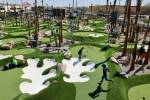Palm Course ideal for weekend warriors
Back in 1989, Arnold Palmer helped create Angel Park Golf Club, a sprawling complex built around the desires -- and limitations -- of recreational golfers. Tough enough to challenge accomplished players, Angel Park's two 18-hole courses were really conceived around the idea that most weekend warriors don't have the length to play 7,000-yard tracks and will become frustrated hitting long irons on every par-4 approach. Two decades later, Angel Park continues to be among the valley's most popular facilities, proving the strategy's soundness.
The shorter of the two tracks, the par-70 Palm Course stretches only 6,500 yards from the tips and plays about a thousand yards less from the resort tees. Most midhandicappers choose the championship tee box, which comes in at approximately 5,850 yards.
For those whose ego permits them to select a set of tees commensurate with their skill level, the formula is simple: Good drives equal short-iron approaches. This gives a decided advantage to shorter but straight hitters, who will get a good look at almost every pin.
The Palm opens with a dogleg left par 4 that is long from the back but friendly from the other tee boxes. Those who have played this course in years past will immediately notice the renovations, through which Angel Park has removed acres of grass in the interest of water efficiency, because the grassy hills that once protected the corner have been supplanted by water-efficient landscaping. This makes a miss left more penal than in the past and discourages corner-cutting. The optimal drive will start at the 150-yard stake and slide to the left, setting up an open look to the slightly elevated and relatively unprotected green.
An early note on Angel Park's putting surfaces: They run significantly faster than the practice greens, and the slope of the valley has a strong influence on every putt. This effect is evident not just in how putts break, but in their speed as well. Golfers would do well to locate the Stratosphere, because it will tug on every putt.
After a couple of birdie chances, the Palm Course teases players with a drive-and-pitch par 4. Although the intimidating tee shot must carry a wide, deep ravine, a solid stroke up the right side takes the front left greenside bunker out of play, providing an unobstructed view of the pin. Angel Park is a course that rewards precision with the short irons, because many of the par 4s can be approached with wedges.
The sixth hole is also the front side's sole par 5. While it measures a scant 525 yards from the back, this serpentine hole more closely resembles hopscotch than golf, justifying its status as the Palm's toughest challenge. Those with the advantage of intestinal fortitude or Manny Ramirez's physician can take the direct route, which demands a long carry over desert to a steeply uphill fairway.
However, it takes a 300-plus-yard drive to carry the hill for even a glimpse at the well-defended green, so the more circuitous route is the more popular. A long-iron or fairway metal from the tee box to the first fairway can be used to set up either a lay-up to the next patch of short grass or a daring leap across the chasm to a green bordered by desert and a pair of large bunkers.
The front side closes with a drivable par 4, with the caveat that any miss short requires a mask and snorkel. The more prudent play is an iron just inside the right fairway bunker, which sets up a virtually risk-free wedge approach. Only a front pin placement should be regarded with caution; any other location is a green-light birdie opportunity.
No. 13 is one of the Palm's two redesigned holes. Under the new configuration, the par 4 plays slightly longer and drifts gently to the right. For those whose ball flight tends to move that way, starting the drive at the center stake and working it to the right edge will create the optimal angle to a severely sloped putting surface.
The final two holes are designed to bolster confidence. While No. 17, a 207-yard par 3, plays across a canyon, there is ample room to land on the triangular green bracketed by two small bunkers. With a hill for a backstop, hitting deep to the fat part of the putting surface isn't a bad choice.
The Palm Course's closing hole has also been renovated and plays significantly shorter, although desert now juts in front of the green from the right. A strong drive down the left side of this 350-yard par 4 will take the hazard out of play. Distance control is critical with the second shot, however, because putting from the wrong level of the two-tiered green is a real adventure.
While many of today's courses seem designed to daunt shorter hitters, Angel Park's Palm Course gives them an opportunity to score well. For those who can wield their wedge like a scalpel, a career day awaits. Angel Park Golf Club is located at 100 S. Rampart Blvd., just off the Summerlin Parkway. For more information or to reserve a tee time, visit www.angelpark.com or call 254-4653.























